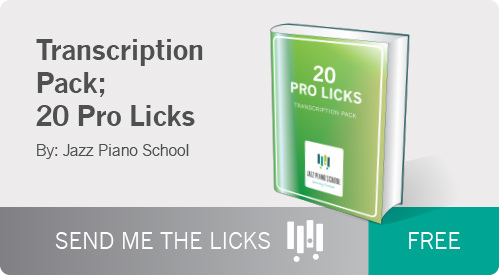In this blog we are going to examine how to play block chords, ala Bill Evans.
Block chord soloing is when you harmonize a melody where all 4 or 5 voices are in rhythmic unison. The two most common forms of block chord soloing that we are going to examine are “locked-hands/double lead” and “drop 2”.
Locked-hands/double lead is when the melody is doubled an octave apart, and the other 3 voices are played within the octave.
- Because all the voices are within an octave, this is referred to as “closed”.
- Bill would be more likely to revert to “locked-hands/double lead” block chord soloing in a trio context.

Drop 2 is where you take the alto voice (the 2nd voice from the top) and “drop” it down an octave.
- Drop 2 voicings provide a fuller, more “open” sound because it contains the interval greater than an octave (usually a 10th).
- Bill would be more likely to resort to “drop 2” block chord soloing in a solo piano setting, without the warmth of the bass.
- Bill does use Drop 2’s in a trio setting as well, only when the range is high enough that locked-hands sound too thin.

Below we are going to look at an example of Bill’s use of drop 2 and locked-hands/double lead block chord soloing from his solo over “On Green Dolphin Street” with the Miles Davis Quintet, which is from 6:41-8:31 in the video below.
Drop 2 Soloing (7:10-7:22)

Locked-Hands/Double Lead Soloing (7:35-7:48)

The above excerpts are over a modal section, so Bill does not need to use much movement and relies on mostly chord tones or notes within the mode. However, if you want to harmonize a more chromatic melody over a more standard set of changes, an understanding of soli techniques is necessary to create movement.
Passing diminished is the most common soli technique Bill uses to create movement while block chord soloing. Below is an example of passing diminished over a C6.

Before embarking upon the challenge of working on block chords, be sure to familiarize yourself with basic harmonization techniques such as passing diminished and chromatic approach. It is also crucial to understand tension & release of a melody so you can adjust your harmonic rhythm & cadences accordingly. If you haven’t checked out my previous article Basic Reharmonization: How To Harmonize A Melody & 5 Basic Reharmonization Techniques, click here to read that first.
Once you understand the principles of how to harmonize a melody, put your knowledge into practice by constructing a melody over a set of chord changes, and use soli techniques to harmonize the melody as a drop 2 and as locked-hands/double lead block chords.
Bijan Taghavi is a pianist, composer, and educator currently based in New York, NY. For more information visit: BijanJazz.com.















One Response
Hi Bijan,
For us amateurs it would be a lot easier if the chords presented would be laid out in C flat mode, this as much as even to read sheet music is difficult enough
Any transposition would then be much easier to carry out when
Rgds
iBo@e